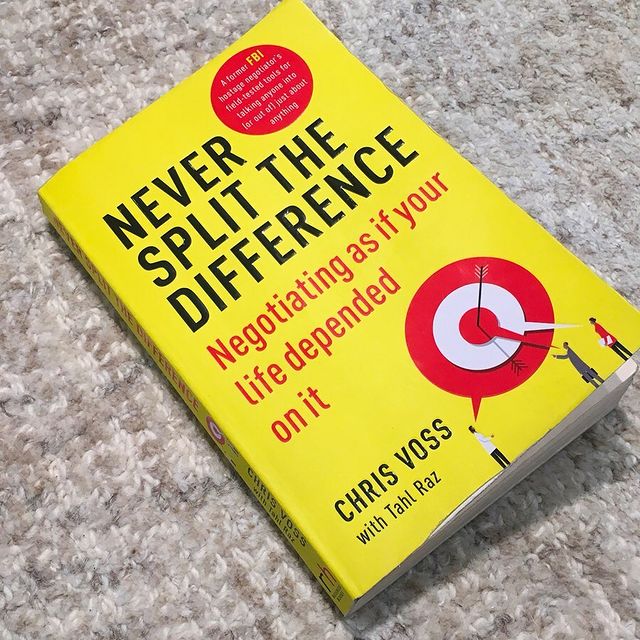
Review : Well written and researched. It offers pragmatic tips and tricks, and useful phrases on negotiation in everyday life. Learnt heaps of things that I didn’t know for example labelling, the meaning of No and types of Yes.
The “Yes” part strikes me the most. There’re prospective clients who told me “Yes” then completely ignore my attempts to follow up. Little did I know that I already failed it. Cause it was indeed a “Counterfeit Yes.” Damn!
Highlights
The “Getting to Yes” system has four basic tenants
① Separate the person – the emotion – from the problem
② Don’t get wrapped up in the other side’s position (what they’re asking for) but instead focus on their interests (why they’re asking for it)
③ Work cooperatively to generate win-win options
④ Establish mutually agreed-upon standards for evaluating those possible solutions
The majority of the interactions we have at work and at home are negotiations that boil down to the expression of a simple, animalistic urge, I want.
Negotiating does not mean browbeating or grinding someone down. It simply means playing the emotional game that human society is set up for. In this world, you get what you ask for: you just have to ask correctly.
We’re easily distracted. We engage in selective listening, hearing only what we want to hear, our. minds acting on a cognitive bias for consistency rather than truth.
We try to be a problem solver, not a people mover. Going too fast is one of the mistakes all negotiations are prone to making. If we’re too much in a hurry, people can feel as if they’re not being heard and we risk undermining the rapport and trust we’ve built.
Talking slowly and clearly, you convey one idea: I’m in control.
Mirroring is a neurobehaviour humans display in which we copy each other to comfort each other. It can be done with speech patterns, body language, vocabulary, tempo, and tone of voice. It’s generally an unconscious behaviour. It follows a very basic but profound biological principle: We fear what’s different and are drawn to what’s similar.
Empathy is “the ability to recognise the perspective of a counterpart and the vocalisation of that recognition.” That’s an academic way of saying that empathy is paying attention to another human being, asking what they are feeling and making a commitment to understanding their world.
Tactical empathy is understanding the feelings and mindset of another in the moment and also hearing what is behind those feelings to you increase your influence in all the moments that follow.
Labelling is a way of validating someone’s emotion by acknowledging it. Think of labelling as a shortcut to intimacy, a time-saving emotional hack. Labels almost always begin with roughly the same words:
• It seems like…
• It sounds like…
• It looks like…
The last rule of labelling is silence. Once you’ve thrown out a label, be quiet and listen. A label’s power is that it invites the other person to reveal himself.
The real meaning of a “No”. When someone tells you “No”, you need to rethink the word in one of its alternative meanings :
• I’m not yet ready to agree
• You’re making me feel uncomfortable
• I don’t understand
• I don’t think I can afford it
• I want something else
• I need more information
• I want to talk it over with someone else.
Learn to see “No” for what it is. Every “No” gets you closer to a “Yes”
• “No” allows the real issues to be brought froth
• “No” protects people from making ineffective decisions
• “No” slows things down so that people can freely embrace their decisions and the agreements they enter into
• “No” helps people feel safe, secure, emotionally comfortable, and in control of their decisions
• “No” moves everyone’s efforts forward.
One great way to antagonise people into “No” is to mislabel the emotions or desires. Another way to force “No” in a negotiation is to ask the other party what they don’t want.
Behavioural Change Stairway Model (BCSM). The model proposes gives stages ① active listening ② empathy ③ rapport ④ influence ⑤ behavioural change.
Instead of asking some closed-ended questions with a single correct answer, ask “how” questions, and “how” engages because “how” asks for help.
Giving your counterpart the illusion of control by asking calibrated questions. It’s best to start with “what”, “how” and sometimes “why”. The only time you can use “why” successfully is when the defensiveness that is created supports that change you are trying to get them to see.
• What about this is important to you?
• How can I help to make this better for us?
• How would you like me to proceed?
• What is it that brought us into this situation?
• How can we solve this problem?
• What’s the objective? What are we trying to accomplish here?
• How am I supposed to do that?
The 7-38-55 % rule. In two famous studies on what makes us like or dislike somebody. That is, only 7% of a message is based on words while 38% comes from the tone of voice and 55% from the speaker’s body language and face.
3 kinds of “Yes”
① Commitment
② Confirmation
③ Counterfeit
One great tool for avoiding getting the counterfeit yes trap is the Rules of Three. It’s simply getting the other guy to agree to the same thing three times in the same conversation.
◃ Back